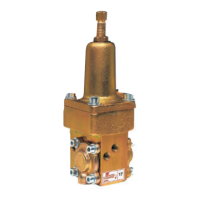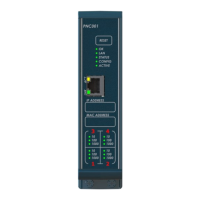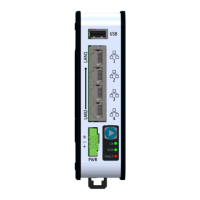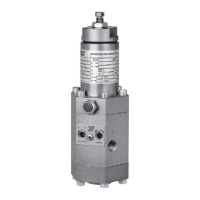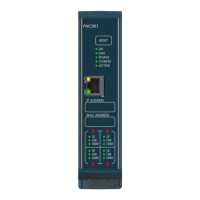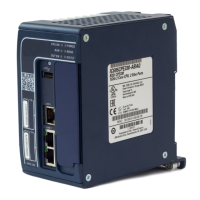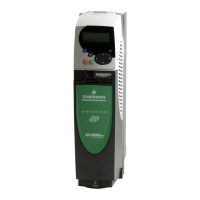Safety
information
Product
information
Mechanical
installation
Electrical
installation
Getting
started
Basic
parameters
Running
the motor
Optimization
NV Media Card
Operation
Onboard
PLC
Advanced
parameters
Technical
data
Diagnostics
UL listing
information
124 Powerdrive F300 User Guide
Issue Number: 2
Used to define the unique address for the drive for the serial interface.
The drive is always a slave address 0 is used to globally address all
slaves, and so this address should not be set in this parameter
These parameters control the proportional and integral gains of the
current controller used in the open loop drive. The current controller
either provides current limits or closed loop torque control by modifying
the drive output frequency. The control loop is also used in its torque
mode during line power supply loss, or when the controlled mode
standard ramp is active and the drive is decelerating, to regulate the flow
of current into the drive.
Open-Loop
There are two autotune tests available in open loop mode, a stationary
and a rotating test. A rotating autotune should be used whenever
possible so the measured value of power factor of the motor is used by
the drive.
• A stationary autotune can be used when the motor is loaded and it is
not possible to remove the load from the motor shaft. The stationary
test measures the Stator Resistance (05.017), Transient Inductance
(05.024), Maximum Deadtime Compensation (05.059) and current at
Maximum Deadtime Compensation (05.060) which are required for
good performance in vector control modes (see Open Loop Control
Mode (00.007), later in this table). If Enable Stator Compensation
(05.049) = 1, then Stator Base Temperature (05.048) is made equal
to Stator Temperature (05.046). The stationary autotune does not
measure the power factor of the motor so the value on the motor
nameplate must be entered into Pr 00.043. To perform a Stationary
autotune, set Pr 00.040 to 1, and provide the drive with both an
enable signal (on terminal 29) and a run signal (on terminal 24).
• A rotating autotune should only be used if the motor is unloaded. A
rotating autotune first performs a stationary autotune, as above, then
a rotating test is performed in which the motor is accelerated with
currently selected ramps up to a frequency of Rated Frequency
(05.006) x
2
/
3
, and the frequency is maintained at that level for 4
seconds. Stator Inductance (05.025) is measured and this value is
used in conjunction with other motor parameters to calculate Rated
Power Factor (05.010). To perform a Rotating autotune, set
Pr 00.040 to 2, and provide the drive with both an enable signal (on
terminal 29) and a run signal (on terminal 24).
Following the completion of an autotune test the drive will go into the
inhibit state. The drive must be placed into a controlled disable condition
before the drive can be made to run at the required reference. The drive
can be put in to a controlled disable condition by removing the Safe
Torque Off signal from terminal 29, setting the Drive Enable (06.015) to
OFF (0) or disabling the drive via the Control Word (06.042) and Control
Word Enable (06.043).
RFC-A
There are four autotune tests available in RFC-A mode, a stationary test,
a rotating test and two inertia measurement tests. A stationary autotune
will give moderate performance whereas a rotating autotune will give
improved performance as it measures the actual values of the motor
parameters required by the drive. An inertia measurement test should be
performed separately to a stationary or rotating autotune.
It is highly recommended that a rotating autotune is performed
(Pr 00.040 set to 2).
• A stationary autotune can be used when the motor is loaded and it is
not possible to remove the load from the motor shaft. The stationary
autotune measures the Stator Resistance (05.017) and Transient
Inductance (05.024) of the motor. These are used to calculate the
current loop gains, and at the end of the test the values in Pr 04.013
and Pr 04.014 are updated. Maximum Deadtime Compensation
(05.059) and Current At Maximum Deadtime Compensation
(05.060) for the drive are also measured. Additionally, if Enable
Stator Compensation (05.049) = 1, then Stator Base Temperature
(05.048) is made equal to Stator Temperature (05.046). A stationary
autotune does not measure the power factor of the motor so the
value on the motor nameplate must be entered into Pr 00.043.
To perform a Stationary autotune, set Pr 00.040 to 1, and provide the
drive with both an enable signal (on terminal 29) and a run signal (on
terminal 24).
• A rotating autotune should only be used if the motor is unloaded. A
rotating autotune first performs a stationary autotune, a rotating test
is then performed which the motor is accelerated with currently
selected ramps up to a frequency of Rated Frequency (05.006)
x
2
/
3
, and the frequency is maintained at the level for up to 40 s.
During the rotating autotune the Stator Inductance (05.025), and the
motor saturation breakpoints (Pr 05.029, Pr 05.030, Pr 06.062 and
Pr 05.063) are modified by the drive. The power factor is also
modified for user information only, but is not used after this point as
the stator inductance is used in the vector control algorithm instead.
To perform a Rotating autotune, set Pr 00.040 to 2, and provide the
drive with both an enable signal (on terminal 29) and a run signal (on
terminal 24).
Following the completion of an autotune test, the drive will go into the
inhibit state. The drive must be placed into a controlled disable condition
before the drive can be made to run at the required reference. The drive
can be put in to a controlled disable condition by removing the Safe
Torque Off signal from terminal 29, setting the Drive Enable (06.015) to
OFF (0) or disabling the drive via the control word (Pr 06.042 &
Pr 06.043).
RFC-S
There are two autotune tests available in RFC-S sensorless mode, a
stationary autotune and an inertia measurement test.
• The stationary autotune can be used to measure all the necessary
parameters for basic control. The tests measures Stator Resistance
(05.017), Ld (05.024), No Load Lq (05.068), Maximum Deadtime
Compensation (05.059) and Current At Maximum Deadtime
Compensation (05.060). If Enable Stator Compensation (05.049) =
00.037 {11.023} Serial Address
RW Num US
OL
Ú
1 to 247
Ö
1RFC-A
RFC-S
00.038 {04.013} Current Controller Kp Gain
RW Num US
OL
Ú
0 to 30000
Ö
20
RFC-A
150
RFC-S
00.039 {04.014} Current Controller Ki Gain
RW Num US
OL
Ú
0 to 30000
Ö
40
RFC-A
ÚÖ
2000
RFC-S
00.040
{05.012}
Auto-tune
RW Num NC
OL
Ú
0 to 2
Ö
0RFC-A
Ú
0 to 5
Ö
RFC-S
Ú
0 to 6
Ö
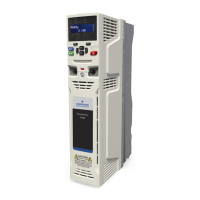
